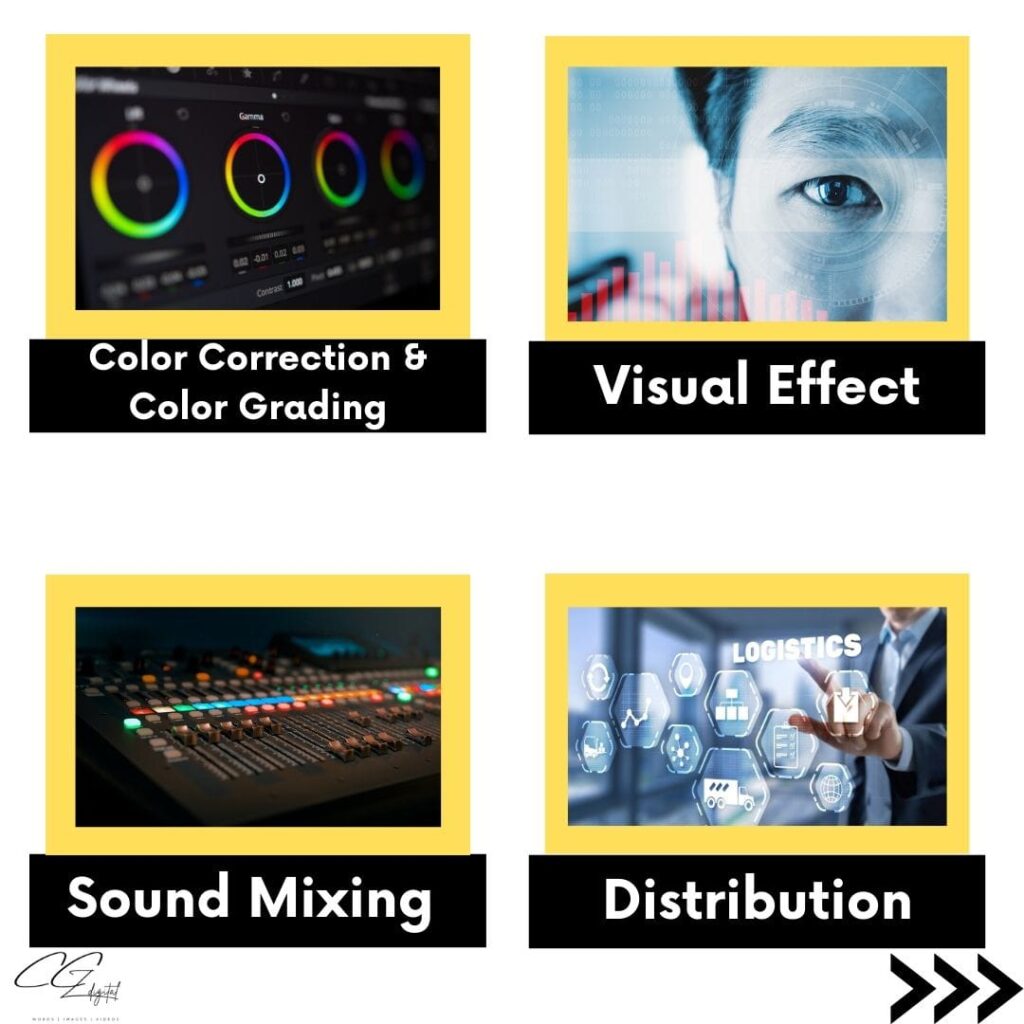Filmmaking is a multistep process that needs to be carried out methodically to create a successful cinematographic project. There are three basic stages of film making namely pre-production, production, and post-production. These three stages are further divided into various steps of filmmaking. Let’s have a look at these steps.
Pre-Production Stage
The pre-production stage is the initial or preparatory stage where all brainstorming and planning are done. This stage includes the following steps of filmmaking
- Idea Generation
The main idea and central characters of the film are decided in this step. The main idea chosen can be original from your observation of the people and events around you. You can also take ideas from a book or writing but then you need to buy copyrights.
- Budgeting
Budgeting is a crucial step of filmmaking and involves planning the entire cost associated with filmmaking. A well-planned budget that covers all rentals, purchases, and hiring as well as hidden costs is necessary for both low and high-budget films. Software offering cost templates can be used to keep track of spending.

Budgeting can also be done using the traditional method. You must first determine the daily cost of shooting. Daily cost includes rent of equipment, location, props and costumes, transportation, food, and salaries of cast and crew. Next, count the number of pages in the script and then divide it by the number of pages you plan to shoot in one day. You then multiply the answer by the daily cost. The traditional method is more suitable for low-budget movies.
- Development of Idea
This step of filmmaking Idea is carried out in the pre-production phase. The idea is explored further and the storyline is developed along the idea by adding details to the concept of how the story will unfold. To enhance the quality of production, idea development must be continued throughout production.
- Scriptwriting and Screenplay writing
Scriptwriting is considered to be “the art of storytelling in a film”. In this step of filmmaking, you pen down the ideas to draft a script. A script contains details of each setting and scene and how the character behaves and interacts. Scriptwriting is not easy as you have to write attention-grabbing dialogues and also describe in detail places and situations for each scene. Scriptwriting must be powerful and clear to convey your thoughts and ideas to the cast and crew. If you lack technical know-how in scriptwriting, the short course can hone your skills. Finally, a screenplay is created which has everything as it will be played on the screen.
- Recruiting and Hiring Cast and Crew
Filmmaking requires collaboration and assistance from people. In low-budget films, you can ask your family, friends, and even film students to step in and volunteer as crew members. However, if you have an adequate budget to hire experienced actors then you should place an advertisement on the casting website. There are various ways to select a cast such as auditions, screen tests, and script read-throughs. Watching showreels is recommended for checking the expertise and technical skills of crew members.
- Scouting Locations and Production Design
In this step of filmmaking, you search for the right exterior and interior venues to set up the scenes that fit the description in the script. It is better to find adaptable locations to accommodate different scenes. Make sure to mention the purpose when renting venues. Also, it is necessary to secure permits when filming outdoors. Technology has made things easier as software can be used to create real-life environments. The production design is an enhanced form of scouting (searching) locations as it also includes preparing for a location by building sets or lighting rigs.

- Storyboard and Shot List
In a film, emotions and feelings can also be conveyed through shots. A storyboard is a visual representation of the script. In this step of filmmaking, the script is broken down into a series of panels, numbered for reference. Storyboarding can be done using software or traditionally through hand-drawn sketches.

Shot list provides information related to the contents of every scene. The information generally revolves around what is needed for the scene.
- Production Schedule
The production schedule is another important step of filmmaking as it helps in planning and organizing the production process. Production schedules can be in the form of a spreadsheet, a daily planner, or a chart with the filming timetable. It helps in keeping track of the various steps in filmmaking and also ensures that everything goes smoothly. Next, you need to make Breakdown Sheets that keep track of everyone and everything in a particular scene. In the final step, create Call Sheets to provide detailed instructions to the crew so that they know what needs to be done, when, where, and by who.
The Production Stage
With all preparation done by following the steps in the pre-production phase, you can begin the production phase. The main step of filmmaking in the production phase is shooting.
- Shooting
Shooting revolves around capturing the audio and video elements of the script on camera. For beginners, production may pose a challenge as they struggle to find the best camera, microphones, and lighting equipment within their budget. You can improvise by experimenting with new camera angles and different lighting. When shooting, follow your storyboard, shot list, and production schedule. Using multiple cameras and shooting multiple takes will let you cover the same scene from different angles. Lighting is a crucial factor when shooting videos, make sure you use adequate and appropriate lighting to set the mood of the scene. Also instead of relying on a built-in mic, invest in a sound system for great-quality audio.
The Post-Production Stage
This final stage includes all the steps of filmmaking that make the raw video and audio presentable to the viewers. This stage comprises the following steps
- Editing
Editing is one of the most important steps of filmmaking and refers to the way various shots and sounds are mixed to create the story most accurately. It requires a lot of expertise as it is the key to making an emotional connection with the viewers. In this step, the best shot of each scene is selected and put together to create a visual version of the script. Editors use software for sharper and smarter cuts.
- Sound Design
Sound in a film is as important as the visuals as it sets the tone of the movie and helps in unfolding the story. The sound design step of filmmaking involves recording and generating additional audio elements. These additional audio elements can be “diegetic sounds” (sounds present in the scene). They can also be “non-diegetic sounds” which are added to set a scene and help tell the story. Sound design requires efficiency as it creates an immersive experience for the viewers. Sound designers need to be careful when mixing and editing sounds to create an impact that enhances the visuals.
- Color Correction
Colors also need to be adjusted to create realistic and true-to-life images. The color correction step of filmmaking ensures accuracy by removing undesired color casts and mismatches. Skin tone is one of the common mismatches and color correction is used to remove it. This step also ensures consistency in colors especially when multiple shots are filmed in the same location.
- Visual Effects
In this step of filmmaking, visual effects that are impractical or impossible to shoot are added to the film. Using the software, visual effects artists easily add or eliminate people, places, or objects in the scene.

The basic aim of adding visual effects is to create imagery that makes places, characters, or stunts believable. It can also be used to correct errors during filming.
- Sound Mixing
Sound mixing is the final step in the audio of a film and is done to create balance among all audio elements in the soundtrack of the film. Sound mixing adjusts the volume of every individual sound to make the message of the video more impactful. This step of filmmaking is a very time-consuming process. For great sound-mixing use fine-quality studio speakers or headphones.
- Color Grading
While color correction makes images seem natural, color grading is done to style the footage in new and rather unnatural ways. This creative process adds emotions and atmosphere to the shots. This step of filmmaking uses filters or palettes to re-tint the frame. INSERT PHOTO
After completing all technical aspects of filmmaking, you can proceed to distribution and promotion, the final steps of filmmaking.
- Distribution
Distribution refers to the marketing of the film. Distributors determine when is the best time to release the film and provide release dates. Distributors also decide the locations where the film would be released.
Although cinemas are the main locations, films are also released on platforms like Amazon, Netflix, and Disney Plus. YouTube is another popular channel for the film release.
- Promotion
Films are advertised to create awareness and build excitement among people. The most common method of promoting a film is through trailers. These trailers are shown on TV, in cinemas, and online to arouse the interest of the audience and attract them.

Conclusion
The creation of a film requires lots of hard work, collaboration, commitment, and expertise. By following the above-mentioned steps of filmmaking, filmmakers can create a film project successfully.
